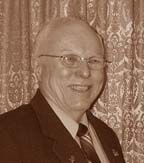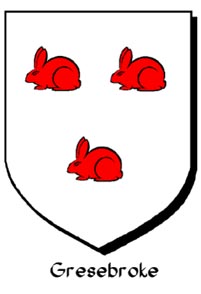The Grazebrook Page
 This page was set up by Robert Sewell in June 2006 to show the Family of
Grazebrook since the earliest known times. Robert Sewell graduated
from McMaster University (Hamilton, Ontario, Canada) in 1967 with a B.Sc.
degree in chemistry. After a year of studies at the University of
Toronto's College of Education, he taught high school science in Collingwood,
Ontario for a year and then taught chemistry, physics and general science
in Hamilton, Ontario for twenty-nine years. Robert Sewell retired
from teaching in June 1998.
This page was set up by Robert Sewell in June 2006 to show the Family of
Grazebrook since the earliest known times. Robert Sewell graduated
from McMaster University (Hamilton, Ontario, Canada) in 1967 with a B.Sc.
degree in chemistry. After a year of studies at the University of
Toronto's College of Education, he taught high school science in Collingwood,
Ontario for a year and then taught chemistry, physics and general science
in Hamilton, Ontario for twenty-nine years. Robert Sewell retired
from teaching in June 1998.
Click
to contact Robert Sewell
Please visit the Sewell
Genealogy Site Map for other pages in this series.

The surname of the Greysbrooke family is
derived from a place so-called near Rotherham, Co. Yorkshire. A suburb
of Rotherham is known as “Greasborough” at the present time, and was a
separate village within living memory. Roger de Gresbroke (in the
time of Henry II, 1154-1189) is mentioned as holding the fee of Alice,
Countess of Ewe, daughter of William de Albiney, Earl of Arundel, by Queen
Adeliza, relict of Henry I. The ancient arms of Gresebrooke are described
as: "Argent, three coneys feeding gules"; which means: "a silver
or white shield with three red rabbits in a feeding position".
The information
presented here, along with the various spellings of the name, have been
taken from Dr. Joseph Jackson Howard: Miscellanea Genealogica et
Heraldica , Volume III, Third Series, Mitchell and Hughes, London,
1900. Click to view a sample
page. Thanks to the late Sewell V. Sample (1928 - 2005) and Eben
W. Graves for sharing the pages from Dr. Jackson's book.
Generation One
Bartholomew de Gresebroke,
a younger son, left the paternal estates in Yorkshire and settled at Shenston,
County Staffordshire. He acquired from Robert de Grendon about 1204
and before 1214 the old manor house of the De Brays, afterwards called
Gresbrok Hall, and an estate in Shenston. A new manor house had been
built about 1190-5. Shenston had been held by the De Brays since
before 1127, and Bartholomew was infeuded subject to the same service to
the chief lords, which explains the unusual tenure which was disclosed
in January 1297 when the heriot was declared by which Gresebrok Hall and
the estates were held; viz. "a horse with saddle and bridle, aketon and
lorica, and other arms appurtenant" on the death of each tenant.
At this point in history, the aketon, (also acton, auqueton, hacketon,
etc.) appears to have been a heavily padded garment worn under the lorica,
which was leather or iron breastplate.
This unusual tenure suggests strongly
that Bartholomew and his descendants were all or mostly knights.
Some instances indicate that the possession of a certain income entailed
the right, perhaps the necessity of knighthood; while others seem to restrict
it entirely to those who personally went to war. Kings, great commanders
and great clergy constantly created knights, and there are many cases of
knights creating other knights, including their own sons and the sons of
others.
Bartholomew also held lands at Ashfurlong,
now in the parish of Sutton-Colefield, and is mentioned in documents circa
1214 - 1242.
Died: before 1268
Married: Edith
Bartholomew de Gresebroke and Edith had the following
children:
-
Adam de Gresbroke, who succeeded his father in his estates,
and was in possession in 1268. Adam d.s.p. (decessit sine prole,
died without issue) before 1294 and was succeeded in the estates by his
brother.
Generation Two
Robert de Gresebroke succeeded
his brother Adam in the possession of the estates and is mentioned in documents
circa 1274 – 1297.
Died: before 1305
Robert de Gresbroke had a son:
Generation Three
Robert de Gresebrooke inherited
Gresbrok Hall and the same estates and is mentioned in documents circa
1308 – 1322.
Robert de Gresebrooke had a son:
Generation Four
Robert de Gresbroke was referred
to as “miles” or “militibus” (a knight or soldier knight) when he appeared
as a witness to a charter on February 12, 1345. Robert is mentioned
in documents circa 1323 – 1348.
Died: 1348
Robert de Gresebrooke had two sons:
-
John de Gresbroke who witnessed three charters dated 1348.
Generation Five
William de Gresbroke inherited
Gresbroke Hall and the same estates and purchased Swetewallemor in Shenston
in 1348.
William de Gresbroke had two sons:
-
William de Gresbroke, who had letters of protection for a
year, going to set out for foreign parts on November 15, 1340.
Generation Six
John de Gresbroke inherited
the same estates and sold Swetewallemoor. John is mentioned in documents
circa 1370 – 1383.
Died: circa 1383
John de Gresbroke had a son:
Generation Seven
John de Gresbroke inherited
the same estates after April, 1383. John is mentioned in documents
circa 1385 – 1407.
Died: circa 1410
John de Gresbroke had a son:
Generation Eight
John de Gresebroke inherited
the same estates after 1407 and before 1413. John is mentioned in
documents circa 1407 – 1445.
John de Gresebroke had a son:
Generation Nine
John Gresbrooke de Shenston
inherited Gresbroke Hall and the same estates. John is mentioned
in documents circa 1473 – 1506.
Died: before 1509
John Gresbrooke had two sons:
-
John Greysbroke who succeeded to Gresbroke Hall and the Shenston
estates, and was referred to as John Greysbroke Junior during his father’s
lifetime and as John Greysbroke Senior after his father’s demise circa
1509.
-
John Gresbrooke of Middleton, a younger brother with
the same Christian name who was referred to as John Gresbrooke of Middleton.
Two brothers with the same Christian name are of frequent occurrence for
300 years before this and perhaps 100 years after.
Generation Ten
John Gresbrooke of Stoke Hall in Middleton
who succeeded to an estate and Stoke Hall in the parish of Middleton, Warwickshire;
less than 6 miles from Gresbroke Hall and the Shenston estates in Staffordshire
where his elder brother lived. Relative to John’s will, Dr. Jackson
Howard states in his Miscellanea Genealogica et Heraldica (1899):
“Proved at Lichfield 1542 ... This will mentions ‘that syde of the Crofte
next the ffrthynge lane’ – an old cottage now stands about a field away
from the junction of Farthing Lane with the name Stoke End. This
was the site of Stoke Hall. At the bottom of a field falling away
at the back lies a pond, now nearly dried up, but still known by the name
of ‘the great lake’”
Died: 1542
Married: Isabell who died in 1554
John Gresbrooke and Isabell had the following children:
-
John Gresbrooke, eldest son. Apparently, there was
some discord in the family. John’s father had stipulated in his will
“... my sone Alverey shall have yt and no other man.” In her will,
John’s mother Isabell named her son John and her son Alverey “desyryng
hym to be good to his brethern and systrs”. However, her husband
did not name John; and after court proceedings, Dr. Jackson Howard states
in his “Miscellanea Genealogica et Heraldica” (1899): “Alverey therefore
turned him out with violence”.
-
Alverey or Alured Greysbrooke
-
Robert Greysbrooke who married Emmes or Emmot. Robert died
in January 1588/9 and Emmes died in December 1605. They had
two sons, Robert and Hugh. Robert, the eldest son, eventually
succeeded to the Middleton estates as heir to his uncle Alverey and Hugh
succeeded to his father’s property in Hints.
-
Henry Gresebrooke who married Elizabeth. Henry died
in April 1557. They had two sons, Richard Greisbrooke and Nicholas
Greisbrooke.
-
Margaret Gresbrooke who married Mr. Shurrocke
-
Elizabeth Gresbrooke who married Mr. Hylley
Generation Eleven
Alverey Greysbrooke, the
second son who inherited the whole of Middleton estates and Stoke Hall.
Alverey is mentioned in documents circa 1540 – 1575. His will is
dated September 24, 1575, was proved at Lichfield March 7, 1576 and the
inventory was dated January 4, 1575/6.
Died: 1575 or 1576.
Married Margaret Keene, daughter of Thomas Keene
of Sutton Coldfield, Warwickshire. Margaret’s mother was Margaret
Gibbons, eldest daughter of William Gibbons of Little Sutton and his wife
Agnes Harman; who was a younger daughter of William Harman (d. 1470) of
Moor Hall and Joan Squire (d. 1523) who was a daughter of Henry Squire.
Agnes Harman was the sister of John Harman alias Vesey, Bishop of Exeter
from 1519 to 1554.
Alverey Greysbrooke and Margaret Keene had the following
children:
-
Margaret Greysbrooke who married before September
1575 to Henry Sewall, Mayor of Coventry in 1578 and 1606.
Henry Shewell’s will is dated September 1, 1624, and he died April 6, 1628
æt 84, therefore he was born in 1544. Margaret’s will is dated
May 7, 1628 and was proved November 23, 1629, and both lie buried in the
Drapers’ Chapel in St. Michael’s, Coventry. For the continuation
of this line, please visit the Sewell Page by clicking on:
Henry
Sewall
-
Anne Greysbrooke who married after 1575 to Thomas Roper.
The ancient coat of arms of Gresbroke, Argent, three coneys feeding gules,
were allowed for in the Visitation of Co. Derby in 1634 and 1662 as a quartering
to the Roper arms.
click here to return to the top
 This page was set up by Robert Sewell in June 2006 to show the Family of
Grazebrook since the earliest known times. Robert Sewell graduated
from McMaster University (Hamilton, Ontario, Canada) in 1967 with a B.Sc.
degree in chemistry. After a year of studies at the University of
Toronto's College of Education, he taught high school science in Collingwood,
Ontario for a year and then taught chemistry, physics and general science
in Hamilton, Ontario for twenty-nine years. Robert Sewell retired
from teaching in June 1998.
This page was set up by Robert Sewell in June 2006 to show the Family of
Grazebrook since the earliest known times. Robert Sewell graduated
from McMaster University (Hamilton, Ontario, Canada) in 1967 with a B.Sc.
degree in chemistry. After a year of studies at the University of
Toronto's College of Education, he taught high school science in Collingwood,
Ontario for a year and then taught chemistry, physics and general science
in Hamilton, Ontario for twenty-nine years. Robert Sewell retired
from teaching in June 1998.

